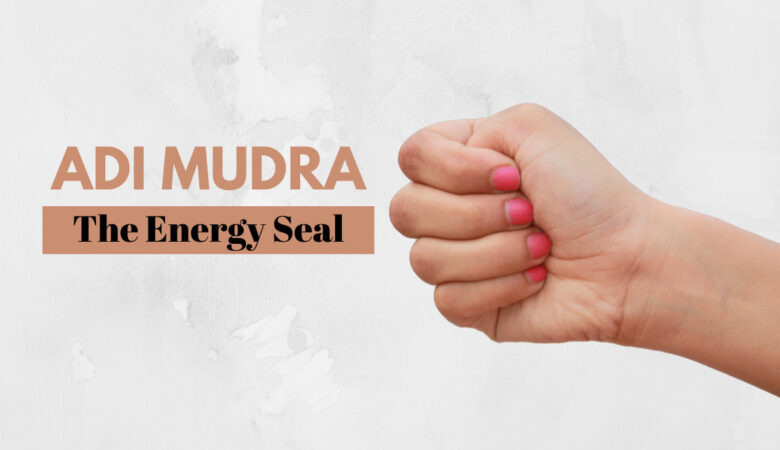In today’s fast-paced and constantly stimulating world, finding mental peace can seem like a distant dream. Whether you’re dealing with anxiety, overstimulation, or the general restlessness of modern life, traditional yogic practices offer simple but powerful techniques to reconnect with stillness. Among these is Adi Mudra, a subtle hand gesture rooted in ancient yogic wisdom, known for its ability to calm the nervous system and quiet the mind. So, see below Adi Mudra benefits for calming mind…
Table of Contents
What Is Adi Mudra?
Adi Mudra, meaning “primordial gesture,” is a yogic hand position that mimics the natural shape of an infant’s fist: the thumb tucked gently into the palm, with the fingers curling over it. It’s symbolic of returning to a basic, pure, and innocent state of being, before thoughts, conditioning, or mental chatter.
Unlike some mudras that involve complex finger arrangements, Adi Mudra is incredibly simple, yet deeply effective. When practiced consistently, especially alongside deep breathing or meditation, it becomes a potent gesture for mental calm, emotional stability, and inner stillness.
Adi Mudra Benefits for Calming Mind:
Stimulates the Parasympathetic Nervous System:
Adi Mudra helps shift the body from a state of “fight or flight” (sympathetic dominance) to “rest and digest” (parasympathetic activation). This physiological shift:
- Slows heart rate
- Lowers blood pressure
- Reduces stress hormone levels like cortisol
Reduces Sensory Overload:
When you form Adi Mudra and close your eyes, your hands create a symbolic and subtle closure to external distractions. This “sealing in” of energy reduces outward awareness and increases introspective focus, essential for meditation and calming thoughts.
Supports Slow, Deep Breathing:
Practicing Adi Mudra during pranayama (breath control) naturally encourages diaphragmatic breathing. Deep breathing slows brain wave activity, promoting alpha and theta waves, which are associated with calmness, creativity, and meditation.
Promotes Grounding and Centering:
By directing energy inward, Adi Mudra acts like a grounding wire, drawing excessive mental energy down into the body. This makes it especially useful during anxiety, overstimulation, or emotional turbulence.
Facilitates Meditation and Mindfulness:
Adi Mudra acts as an anchor for awareness. Holding the gesture becomes a focal point, helping you stay present and aware of the moment, reducing wandering thoughts and mental agitation.
Reduces Anxiety and Nervousness:
By calming the nervous system and quieting excessive thought activity, Adi Mudra helps soothe anxiety, restlessness, and emotional overwhelm.
Improves Focus and Mental Clarity:
Adi Mudra encourages stillness, helping reduce mental clutter. This improved clarity enhances your ability to concentrate during tasks, studies, or spiritual practices.
Supports Emotional Balance:
When practiced regularly, Adi Mudra helps bring emotional fluctuations into balance. It fosters a sense of detachment, not in the sense of being numb, but in maintaining peace in the midst of changing emotions.
Aids in Better Sleep:
By activating relaxation responses and reducing mental hyperactivity, Adi Mudra can be a useful bedtime practice to quiet the mind and improve sleep quality.
Deepens Meditation Practice:
For those who meditate, Adi Mudra enhances the experience by helping withdraw the senses (pratyahara) and supporting internal awareness. It can be especially useful during mantra meditation, breathwork, or silent sitting.
When and How to Practice for Mental Calm:
Ideal Times:
- Early morning (to set a calm tone for the day)
- Before meditation or pranayama
- Before sleep (to unwind and prepare the mind)
- During stressful moments (to restore equilibrium)
Recommended Duration:
- Beginners: Start with 5–7 minutes
- Intermediate/Advanced: 15–30 minutes daily
- Combine with slow breathing or meditative music for enhanced effects
How to Practice Adi Mudra for Mind Calming:
- Sit comfortably with your spine erect.
- Place your hands on your thighs, palms facing up.
- Tuck your thumbs gently into the center of your palms.
- Curl your fingers over your thumbs to form a loose fist.
- Turn your fists downward so the knuckles rest on your thighs.
- Close your eyes and begin slow, deep breathing.
- Focus on the movement of your breath or repeat a calming mantra like “So-Ham.”
- Continue for 5-15 minutes, then slowly release and observe the effects.
Tips & Precautions
- Practice on an empty stomach or at least 1-2 hours after eating.
- Do not grip the gesture too tightly should be relaxed.
- Combine with slow exhalations to deepen the calming effect.
- Avoid if you have hand injuries or conditions that prevent comfortable hand positions.
Final Thoughts:
Amid mental storms, Adi Mudra serves as a gentle anchor. Its simplicity is deceptive; within its soft fist lies the power to reconnect you with the quiet core of your being. Whether you’re a beginner in yoga or a seasoned meditator, incorporating Adi Mudra into your routine can bring measurable calm, clarity, and peace.
Sometimes, all it takes to soothe the mind is not a grand solution, but a quiet, ancient gesture whispering you back into the present.





